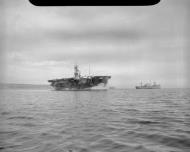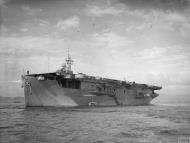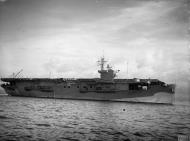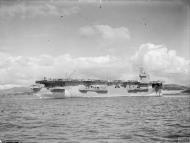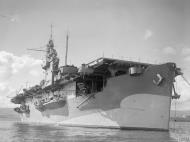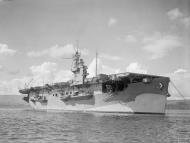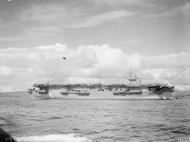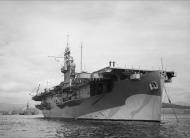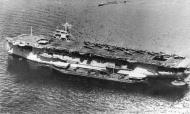USS Barnes - HMS Attacker (D02) - General characteristics
General characteristics
Name: USS Barnes
Builder: Western Pipe and Steel Company
Laid down: 17 April 1941
Launched: 27 September 1941
Acquired: December 1941
Reinstated: 6 January 1946
Fate: Sold into Merchant service February 1947, Career (UK)
Class and type: Attacker-class escort carrier
Name: HMS Attacker
Commissioned: 30 September 1942
Decommissioned: 6 January 1946 and returned to the USN
|
Displacement: 11,420 long tons (11,600 t) deep load
Length: 492.25 ft (150.04 m)
Beam: 69.5 ft (21.2 m)
Draught: 26 ft (7.9 m)
Propulsion: Steam turbines, 1 shaft, 8,500 brake horsepower
Speed: 17 knots (31 km/h; 20 mph)
Complement: 646 officers and enlisted
Armament: 2 X 4 inch dual purpose, AA guns in single mounts, 8 X 40 mm AA guns in twin mounts, 21 X 20 mm AA cannons in single and twin mounts
Aircraft carried: 24
Honours and awards: Atlantic 1943–1944, Salerno 1943, South France 1944, Aegean 1944[1] |
HMS Attacker (D02) was an American-built Attacker-class escort aircraft carrier that served with the Royal Navy during the Second World War.
Converted from the merchantman Steel Artisan, she was commissioned by the United States Navy on 30 September 1942 as USS Barnes (CVE-7) but simultaneously transferred under the Lend-Lease program to the United Kingdom and commissioned by the Royal Navy as HMS Attacker (D02) the same day.
Attacker served throughout the war, first as a convoy escort in the Atlantic. After further conversion by the Royal Navy in October 1943 as an assault carrier, the ship was busily engaged in the Mediterranean and later the Pacific theatres of war. In late August, Attacker witnessed the Japanese surrender of Malaya in Penang, as part of Operation Zipper.
Design and description
She had been laid down on 17 April 1941 as the merchantman Steel Artisan (hull 160) under Maritime Commission contract by Western Pipe and Steel Company, San Francisco, California for the Ithanian Steamship Company and was launched in late September. She was then requisitioned for conversion to a carrier in December 1941 to be named USS Barnes but selected for transfer under Lend-Lease to the British.
HMS Attacker was the lead ship in the Attacker class of eight escort carriers, just one of the 38 escort carriers built in the United States for the Royal Navy during the Second World War.[2][3] She was built at the Western Pipe & Steel shipyards, who also built three other ships in the class.[2] Once completed she was supplied under the terms of Lend-Lease agreement to the Royal Navy. There was a ships complement of 646 men, who lived in crew accommodation that was significantly different from the arrangements that were normal for the Royal Navy at the time. The separate messes no longer had to prepare their own food, as everything was cooked in the galley and served cafeteria style in a central dining area. They were also equipped with a modern laundry and a barber shop. The traditional hammocks were replaced by three-tier bunk-beds, 18 to a cabin which were hinged and could be tied up to provide extra space when not in use.[4]
Attackers dimensions were: an overall length of 492.25 feet (150.04 m), a beam of 69.5 feet (21.2 m) and a height of 23.25 ft (7.09 m). They displaced 11,420 long tons (11,600 t) at deep load.[5] Propulsion was provided by four diesel engines connected to one shaft giving 8,500 brake horsepower (BHP), which could propel the ship at 17 knots (31 km/h; 20 mph).[6]
She had the capacity for up to 24 anti-submarine or fighter aircraft, which could be made up of a mixture of the British Hawker Sea Hurricane, Supermarine Seafire, Fairey Swordfish or the American Grumman Wildcat, Vought F4U Corsair or Grumman Avenger.[5] The exact composition of the embarked squadrons depended upon the mission. Some squadrons were composite squadrons for convoy defence and would be equipped with anti-submarine and fighter aircraft,[7] while other squadrons working in a strike carrier role would only be equipped with fighter aircraft.[8] Aircraft facilities were a small combined bridge–flight control on the starboard side and above the 450 feet (140 m) x 120 feet (37 m) flight deck,[9] two aircraft lifts 42 feet (13 m) by 34 feet (10 m), and nine arrestor wires. Aircraft could be housed in the 260 feet (79 m) by 62 feet (19 m) hangar below the flight deck.[5]
The ships armament concentrated on anti-aircraft (AA) defence and comprised two 4 inch dual purpose, AA guns in single mounts, eight 40 mm AA guns in twin mounts and twenty-one 20 mm AA cannons, in single and twin mounts.[5][10]
Before entering service with the Royal Navy she was sent to Burrards shipbuilders in British Columbia for some modifications. These modifications, 150 of them in total, were paid for by the Canadian government.[11] Further modifications to turn her into an assault carriers were undertaken by the Caledon Shipbuilding & Engineering Company in Dundee, Scotland. This work included installing an operational telephone system with over 100 telephones. A new briefing room with an army plot was installed and extra cabins were built providing an additional 140 bunks.[12]
Attacker was designed to accompany other ships forming the escort for convoys.[13] The anti-submarine aircraft employed were initially the Fairey Swordfish and later the Grumman Avenger, which could be armed with torpedoes, depth charges, 250 pounds (110 kg) bombs or the RP-3 rocket projectile.[14] As well as carrying out their own attacks on U-Boats, these aircraft identified their locations for the convoy's escorts to mount an attack.[15] Typically anti-submarine patrols would be flown between dawn and dusk. One aircraft would fly about 10 miles (16 km) ahead of the convoy, while another patrolled astern. Patrols would last between two and three hours, using both Radar and visual observation in their search for U-Boats.[16] Attacker also had a secondary role, providing oil and provisions for her accompanying destroyers. This could be a lengthy process and was done on the move. It took 40 minutes from firing a line across to the destroyer to start pumping oil, while it took another two hours to pump 98 tons of oil and a further 35 minutes to disconnect the hose pipe and secure the equipment.[17]
History
Attacker served throughout the war, first as a convoy escort in the Atlantic. After further conversion by the Royal Navy in October 1943 as an assault carrier, the ship was busily engaged in the Mediterranean and later the Pacific war theatres. In late August, Attacker witnessed the Japanese surrender of Malaya in Penang, as part of Operation Zipper.
In September 1945, Attacker was present at Singapore as part of Operation Tiderace, sailing immediately afterwards for the Clyde to de-store and enter reserve. HMS Attacker was awarded Royal Navy honours for her contribution to the Battle of the Atlantic (1943–44), for support to the Salerno landings (1943) and to the South France and Aegean campaigns in 1944. The vessel left British waters in December 1945, being formally received back into United States' custody at Norfolk Navy Yard, Norfolk, Virginia on 5 January 1946 and struck from naval service on 26 February 1946.
Merchant service
In February 1947 the ship was sold into merchant service — to National Bulk Carriers of New York — who arranged for the removal of the vessel's flight deck and other wartime fittings, in preparation for conversion to a cargo ship. However, the work then stopped and eventually the vessel was offered for re-sale. In 1950 it was bought by the Vlasov group and placed under the nominal ownership of Vlasov's American subsidiary, Navcot Corporation. Re-named Castel Forte, the ship remained idle whilst suitable employment could be found.[18]
In 1957, Vlasov secured a charter from the Australian government for Castel Forte to carry British migrants to Australia. During the conversion passenger liner was re-named Fairsky, operated by Vlasov's Italian managed company, Sitmar Line.[18] On completion of the refurbishment in June 1958, the "new-look" vessel began a long career as a migrant-carrying ship, which was to last until 1970. On 23 June 1977, while operating as a cruise ship, Fairsky hit a submerged wreck and was beached to prevent sinking. The damage was temporarily patched and the ship refloated six days later. When the full extent of the damage became known, Sitmar decided against permanent repairs and the offered the vessel for sale.[19]
Having been reprieved from going straight to the breakers, in 1978 work began to convert the vessel to a static floating hotel and casino named Philippine Tourist. However, the ship was badly damaged by fire on 3 November 1979 and subsequently scrapped in Hong Kong, the hulk having arrived there under tow on 24 May 1980.[19]
ATTACKER-Class Escort Aircraft Carrier obtained under US/UK Land Lease Agreement. The ship was under construction at San Francisco by Western Pipe and Steel Corporation for the Ithanian Steamship Company and had been laid down on 7th April 1941 as Yard No.62. She was launched on 27th September 1941 as STEEL ARTISAN and requisitioned by the US Navy on 26th December 1941 for conversion as an auxiliary aircraft carrier to be named USS BARNES (AVG7). She was later selected, with nine others of this Class for transfer to the RN. Design changes made were based on the experience gained with the earlier ARCHER Class and included a larger hangar. Propulsion machinery consisted of two steam turbines driving a single shaft instead of Diesel engines used for previous ships. Her build was completed on 30th September 1942 when the ship was formally transferred to the RN as HMS ATTACKER. This name had not previously been used for an RN warship.
I’m the researcher at 1000aircraftphotos.com.
There is an error at the HMS Attacker page. The Fairey Swordfish Squadron used in the commissioning of the ship was No.838 Squadron, not No.842. See this HMS Attacker page.
Furthermore No.842 Squadron was formed in March 1943, while No.838 was formed May 1942.
Thought you like to be informed.
Cheers, Johan Visschedijk
Royal Navy Research Archive Org UK HMS ATTACKER Gallery
FAA 838 squadron
The squadron officially formed for the first time at Dartmouth, Canada in May 1942 as a torpedo bomber reconnaissance Swordfish squadron for service with escort carriers. The squadron flew to USNAS Alameda Island, USA in August 1942, embarking on HMS Attacker in December 1942 for the Panama Canal, returning to Quonset Point, and subsequently re-embarking for convoy duties to Curacao. In April 1943, at Machrihanish the squadron was allocated for MAC-ship service, after training on HMS Argus and HMS Activity, and embarked for trials on the MAC-ship Rapana in August 1943, after which the squadron was merged into 836 squadron as L Flight.
The squadron reformed in November 1943 at Belfast with 4 Swordfish IIs, working up in HMS Nairana. In April 1944 the squadron joined 156 Wing RAF Coastal Command at Harrowbeer for operations in the English Channel, subsequently joining RAF coastal Command in Fraserburgh in October 1944. Later in October 1944 a fighter flight of 4 Wildcat IVs was formed at Eglington but subsequently transferred to 856 squadron. In November 1944 the squadron moved to Thorney Island and disbanded in February 1945.
Battle Honours: Atlantic 1943, Normandy 1944.
Commanding Officers and Squadron Personnel
L/C JRC Callandar, RN May 1942-June 1943
L/C(A) RG Large, RNVR June 1943-Aug 1943
L/C(A) JM Brown, DSC, RNVR Nov 1943-Aug 1944
L/C P Snow, RN Aug 1944-Feb 1945
Aircraft
Swordfish I May 1942-April 1943
Swordfish II April 1943-Feb 1945
Swordfish III May 1944-Feb 1945
Wildcat VI Oct 1944-Nov 1944
FAA 842 squadron
The squadron first formed as a torpedo bomber reconnaissance Swordfish squadron at Lee-on-Solent in March 1943. In July 1943 a fighter flight of 6 Seafires was added and the squadron subsequently embarked on HMS Fencer for operations during the occupation of the Azores, and from November 4 Wildcat from 1832 squadron were attached to 842 squadron. On 1 December 1943 one of the Wildcat shot down and enemy aircraft, whilst on Gibraltar convoy duties.
Successful attack in Operation Tungsten of 3 April 1944 on the Tirpitz in Kaa Fjord, North Norway by 827 and 830 squadron Barracuda dive-bombers from HMS Furious and HMS Victorious and supported by the 7th Naval Fighter Wing, HMS Furious 2 fighter squadrons whilst an 842Q sdqn detachment provided a/s patrols from HMS Furious
On 10 February 1944 a Swordfish sank the U-Boat U-666, and in April 1944 the squadron Swordfish provided anti-submarine patrols during the Operation Tungsten attack against the German battleship Tirpitz in Kaa Fjord, North Norway. In May the squadron provided escort on Arctic convoys to Russia when 11 attacks were made on U-Boats, and U-277, U-874 and U-959 were sunk on 1-2 May 1944.
In July 1944, most of the squadron embarked on HMS Indefatigable and HMS Furious for anti-submarine duties during the operation Mascot attack against the Tirpitz, and a detachment of 6 Swordfish and 5 Wildcats embarked on HMS Fencer for Gibraltar convoys, the Wildcats subsequently taking part in operations off Norway from HMS Fencer and then Campania. Meanwhile the Swordfish were attached to RAF Coastal Command at Benbecula in September 1944, transferring to Thorney Island from November 1944.
The squadron disbanded at Thorney Island in January 1945.
Battle Honours: Atlantic 1943 - 4, Norway 1944, Arctic 1944
Commanding Officers and Squadron Personnel
L/C (A) CB Lamb, DSO, DSC, RN March 1943-April 1943
L/C(A) LR Tivy, RN April 1943-March 1944
L/C(A) GFS Hodson, RNR March 1944-Aug 1944
L/C(A) LA Edwards, RN Aug 1944-Jan 1945
Aircraft
Swordfish II Feb 1943-Jan 1945
Seafire L.IIc July 1943-Aug 1943
Seafire Ib July 1943-March 1944
Wildcat V Nov 1943-Nov 1944
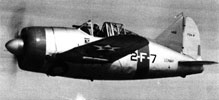
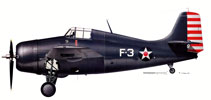
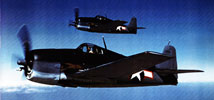
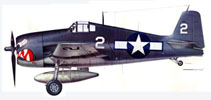
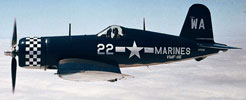
 Editor for Asisbiz: Matthew Laird Acred
Editor for Asisbiz: Matthew Laird Acred
